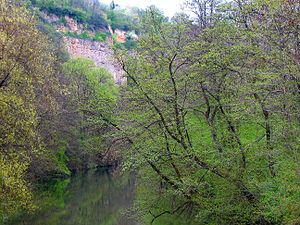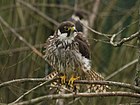Lower Remstal (bird sanctuary)
|
Bird sanctuary (SPA)
"Lower Remstal" |
||
|
The Rems near the mouth at Neckarrems |
||
| location | District of Ludwigsburg and Rems-Murr-Kreis , Baden-Württemberg , Germany | |
| WDPA ID | 555537870 | |
| Natura 2000 ID | DE-7121-442 | |
| Bird sanctuary | 5.714 km² | |
| Geographical location | 48 ° 52 ' N , 9 ° 18' E | |
|
|
||
| Setup date | November 20, 2007 | |
| administration | Regional Council Stuttgart | |
The Lower Remstal area is a European bird sanctuary (protected area identifier DE-7121-442) in the district of Ludwigsburg and Rems-Murr district in Baden-Württemberg in Germany, which was designated by ordinance of November 20, 2007 by the Stuttgart regional council .
location
The approximately 570 hectare (ha) large protected area "Lower Remstal" encloses the eponymous Rems valley between Waiblingen and Neckarrems and the adjacent Hartwald. It is distributed over three cities in two counties:
-
District of Ludwigsburg (159.9 ha)
- City of Remseck am Neckar (159.87 ha = 27.97%)
-
Rems-Murr district (411.5 ha)
- Cities Fellbach (119.12 ha = 20.84%) and Waiblingen (292.43 ha = 51.17%)
description
The protected area "Lower Remstal" is described as "the scenic Kerbtal of the Rems with large loops and in places natural river dynamics as well as the south-west adjoining plateau of the hard forest with meadow orchards to the south".
meaning
The bird sanctuary “Unteres Remstal” is a regular breeding area for peregrine falcon and eagle owl and one of the few areas in Baden-Württemberg with breeding occurrences of the goose saw .
Habitat classes
| Non-forest areas with wooden plants, scrub, etc. | 21% | |||
| Deciduous forest | 23% | |||
| Mixed forest | 25% | |||
| Inland waters, standing and flowing | 4% | |||
| Reclaimed grassland | 8th % | |||
| Different farmland | 17% | |||
| Other (cities, roads, landfills, pits, industrial areas) | 2% | |||
Protection purpose
The area-related conservation objectives are described differently depending on the species :
Breeding birds
Breeding bird species that are listed in Appendix I of the Birds Directive and for which special measures are to be applied across Europe. A total of 39 species fall into this category in Baden-Württemberg and eight species in the “Lower Remstal” protected area .
Kingfisher ( Alcedo atthis )
Preservation of near-natural waters, of steep walls and demolition edges made of excavable substrate in the vicinity of the water, of fallen trees suitable for the breeding tube system in the vicinity of the water, of structures that can be used as a seat for hunting such as strong riparian wood with branches hanging over the water, preservation of a Water quality that ensures good visibility for prey, a water dynamic that enables the formation of new bank breaks suitable for nesting, preservation of secondary habitats such as abandoned mining sites with bodies of water and steep banks, the food supply with small fish species and juvenile fish as well as the maintenance of undisturbed or at least undisturbed breeding sites during the breeding season from February 15th to September 15th.
Gray woodpecker ( Picus canus )
Preservation of richly structured light deciduous and mixed deciduous forests with open areas for feeding, of alluvial forests, of extensively cultivated orchards, preservation of poor grasslands, poor hay meadows or cattle pastures, preservation of edge strips, rain areas, embankments and lined, stepped forest edges, of old wood islands and old wood islands , especially of standing dead wood, preservation of trees with large caves and the food supply.
Collared Flycatcher ( Ficedula albicollis )
Preservation of extensively managed orchards with a high proportion of pome fruit, light deciduous and alluvial forests, old trees and islands of old wood, trees with caves and the maintenance of the food supply, especially with insects.
Middle Woodpecker ( Dendrocopos medius )
Preservation of deciduous and mixed deciduous forests, especially those with oak, of alluvial and alder forests, of extensively cultivated orchards, of old trees and islands of old wood, of standing dead wood and trees with caves.
Red- backed shrike ( Lanius collurio )
Preservation of extensively managed orchards, grassland and heathland areas, of low and medium hedges from native species, in particular thorn or prickly wooded trees, preservation of litter meadows and open bog edges, preservation of individual trees and bushes in the open landscape, of field lines, grass paths, Ruderal and perennial corridors and fallow land, field and meadow margins, secondary habitats such as abandoned mining sites with the aforementioned habitats and maintenance of the food supply, especially with larger insects.
Black Woodpecker ( Dryocopus martius )
Preservation of extensive forests, old trees and islands of old wood, dead wood, preservation of trees with large caves as well as the food supply, especially with ants.
Eagle owl ( Bubo bubo )
Preservation of open rock walls and quarries, each with caves, niches and ledges, preservation of richly structured cultural landscapes in the vicinity of the aforementioned habitats, of open meadow areas with hedges, preservation of habitats without sources of danger such as non-bird-safe overhead lines and wind turbines as well as disruption-free or at least disruption-free reproductive and resting places.
Peregrine falcon ( Falco peregrinus )
Preservation of the open rock walls and quarries with caves, niches and ledges, preservation of habitats without sources of danger such as non-bird-safe overhead lines and unsecured chimneys as well as preservation of undisturbed or at least undisturbed breeding sites during reproduction in the period from February 15 to July 30.
Migratory birds
Other migratory bird species not listed in Appendix I that breed in the country and have been selected for the protected areas. A total of 36 species fall into this category in Baden-Württemberg and four in the “Lower Remstal” protected area.
Tree falcon ( Falco subbuteo )
Preservation of light forests with bordering open landscapes, of old trees and islands of old wood, of overhangs, of field trees or groups of trees in fields or along waterways, of extensively used grassland, of waterways with structurally rich bank areas and silting areas, of nesting opportunities such as crow's nests, of the food supply, in particular with small birds and large insects as well as undisturbed or at least undisturbed breeding sites during the breeding season from April 15 to September 15.
Goosander ( Mergus merganser )
Preservation of the natural and near-natural wetlands such as river valleys, floodplain landscapes and moors, the populated waters, the shallow water zones in standing and weakly flowing waters with rich underwater and bank vegetation, the covered silted areas with reed beds of different age structures and large sedge areas, maintenance of a water quality that offers good visibility Guaranteed for prey capture, preservation of secondary habitats such as peat cuttings and ponds with the aforementioned habitats, preservation of the food supply with small fish species and young fish populations as well as amphibians as well as preservation of undisturbed or at least undisturbed resting, moulting, wintering and foraging areas.
Stock dove ( Columba oenas )
Preservation of deciduous and mixed deciduous forests, of old trees and old wood islands, of trees with large caves as well as grassland areas and extensively used fields with fallow land, strips of field margins and weed-rich grass borders.
Reversible neck ( Jynx torquilla )
Preservation of loosened deciduous, mixed and pine forests in dry locations as well as alluvial forests with clearings or on the edge of open land, preservation of extensively managed orchards, grasslands, heather and stone bar hedge areas, of lean hay meadows or cattle pastures as well as wooded fields, preservation of temporary differentiated uses in grassland, of old trees and old wood islands, of trees with caves, preservation of edge strips, rainen, embankments and fringed stepped forest edges as well as preservation of the food supply, especially with meadow ants.
See also
Web links
- Ordinance, data evaluation sheet and map in the profile of the SPA area in the LUBW's protected area directory
Individual evidence
- ↑ Ordinance of the Ministry of Food and Rural Areas establishing European Bird Protection Areas (VSG-VO) of February 5, 2010
- ↑ Profile of the SPA area in the protected area directory of the LUBW , with "Bird Protection Area Ordinance Annex 1"










